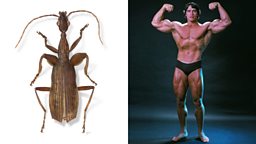11 things we know about the secretive giant squid
Scientists know very little about the elusive giant squid, which lives at ocean depths of between 300 and 1000m or more. Much of what they do know comes from the remains of dead or dying specimens, one of which was caught off the coast of the Falkland Islands in March 2004 and is now preserved at the .
1. Hard to swallow
The giant squid’s gullet passes through its doughnut-shaped brain. This means it cannot swallow large pieces of food.

2. Beak of nature
Giant squid have a parrot-like beak between their eight arms and two tentacles. It is used to kill prey and to tear it into pieces small enough to ingest.

Is the giant squid a monster?
Matthias Classen, Edith Widder and Emily Alder on the 'alien' creature of the deep.
3. Jetsquid
Squid use a jet propulsion system to power themselves through the water and have three hearts that pump blue blood.
4. The eyes have it
Giant and colossal squid have the largest eyes in the animal kingdom. The eyes of a giant squid are the size of dinner plates and eyes up to 35cm in diameter have been reported. It’s thought they evolved to spot large predators, such as sperm whales. They do not have irises or eyelids as they are used to the dimmest possible light.
5. Giant but not colossal
The giant squid weighs around 275kg and grows to up to 14m. The colossal squid weighs around 495kg. No-one knows how much the flipping massive squid weighs.

6. The Silence of the Squid
One giant squid was found to have the remains of other giant squid in its stomach, suggesting they sometimes resort to cannibalism – although it's not clear how often.
7. Small world
Researchers studied 43 samples of giant squid tissue from around the globe and found almost no genetic differences between individuals despite the geographic range.
8. Serrated suckers
Teeth-filled suckers cover their eight arms and the clubs of their two extra long tentacles. The suckers are used to grab and drag prey.

9. Black in blue
Giant squid’s reddish colour provides camouflage in the deep sea because the only available light is blue. Red pigment absorbs blue light so the squid appears to be black and inconspicuous.
10. DIY
Female deep sea squid are believed to store sperm around their arms and head so they can fertilise themselves when they are ready. While singing ‘Sisters are Doin’ It for Themselves’.

Archie the female giant squid
Jon Ablett introduces the Natural History Museum's 8.62m giant squid.
11. Natural Histo-wee
Ammonia released from the tissue of a giant squid specimen made the whole Natural History Museum smell like urine. Well that’s their story, anyway.
Sources: Natural Histories and Natural History Museum.
-
![]()
Natural Histories comedy with Shaun Keaveny.
Sharks
-
![]()
Find out if you've got enough bite for shark life.
-
![]()
Ten reasons why Spielbergβs classic was so thrilling.
-
![]()
Professor John Γ Maoilearca on the negative impact of Jaws on sharks and our perception of them.
-
![]()
The Nineties. Blur, Damien Hirst, the Grouchoβ¦ and the worldβs most famous shark... It was ART, man.
Butterflies
-
![]()
From milk theft to bomb detection, read our butterfly facts!
-
![]()
Natural Histories Comedy: The world's most narcissistic butterfly tells us all about herself.
-
![]()
How many British butterflies can you recognise? Try our quiz!
-
![]()
Peter Marren explains how the red admiral butterfly was once seen as sinister.






















































